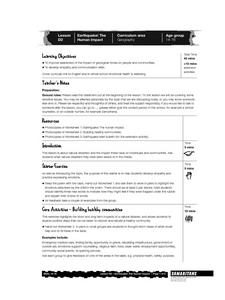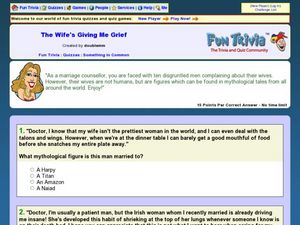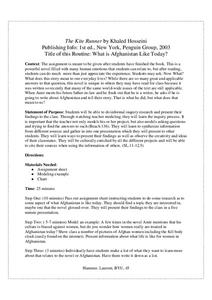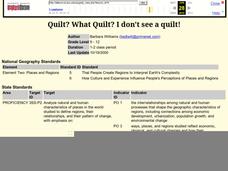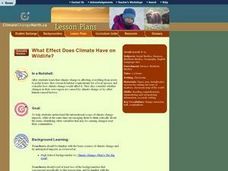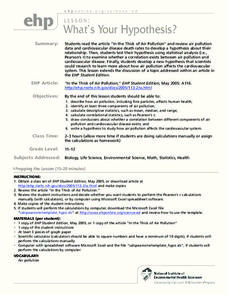Curated OER
What Is History?
Students process a variety of information on the reasons for different interpretations of history.
Curated OER
How Germs are Spread and Prevented
Third graders gain understanding of the human body by identifying three pictures of bacteria/viruses on a sheet of paper and orally name what germs are, ways germs are spread, and how to prevent from spreading germs.
Curated OER
Human Fingerprints: No Two The Same
Students will be offered numerous opportunities to further enhance their observational skills as well as the integration of math with their continual exposure to the metric system, measurement, and graphing to represent their data....
Curated OER
What can I do?
Students identify feelings and explore positive ways to handle conflict. In this mental health lesson plan students discuss feelings and how to constructively handle them.
Curated OER
What is a Haiku? How Do You Write a Haiku?
Haiku poetry is explored in this language arts lesson. Yong readers identify the characteristics of haiku and read several examples. Students make connections between their study of Japan and the poetic form of haiku, and they write...
Curated OER
Bio-What
Students explore the concept of biodiversity. Through activities, they discover the importance of one species upon another. Students examine food webs, discuss animals interdependence upon one another, and brainstorm why biodiversity is...
Curated OER
Earthquake! The Human Impact
Students explore the impact of natural disasters on communities. In this character education lesson plan, students examine poetry regarding an earthquake. Students discuss how to rebuild communities in the wake of natural...
Curated OER
The Wife's Giving Me Grief
Pretend you are a marriage counselor to the ancients. Based on the problems you are told about, can you guess who the mythological figures are? This creative quiz adds a little fun into identifying characters based on their relationship...
Curated OER
What on Earth is in the Earth?
Pupils explore the physical properties of sand, soil, and rocks and sort, classify, compare, and contrast the materials found in the soil. The differences between the living and non-living parts of the soil is discussed.
Curated OER
Cave Art: Discovering Prehistoric Humans through Pictures
Students explore how people in earlier times used art as a way to record stories and communicate ideas by studying paintings from the Cave of Lascaux and other caves in France. Three lessons on one page.
Curated OER
The Kite Runner: What is Afghanistan Like Today?
After completing Khaled Hosseini's The Kite Runner, readers research a topic of interest and prepare a five-minute presentation, and share their findings with the class.
Curated OER
Quilt? What Quilt? I Don't See a Quilt!
Students analyze maps and cultures of major cities in the state of Arizona and designate different regions within the state according to geography and economy.
Curated OER
What Effect Does Climate Have on Wildlife?
Students explore the international scope of climate change. They identify variables that cause changes in the climate. Students examine how changes in climate affect the food chain.
Curated OER
What Can I Do?
Students discuss feelings and ways to deal with problems. In this conflict resolution activity, students identify their feelings and learn ways to resolve conflicts with others.
Curated OER
Chapter 9: Language Processing: Humans and Computers
Designed to accompany An Introduction to Language by Victoria Fromkin, Robert Rodman, and Nina Hyams, this powerpoint addresses a number of language, technological, and sociological topics. The slides could be helpful in either a...
Curated OER
What Is El Niño?
Students access information at remote sites using telecommunications, identify impacts by reviewing past El Ni??o events, make and use scale drawings, maps, and maps symbols to find locations and describe relationships.
Curated OER
Are You One of Us?
Students compare and contrast insects and arthropods, identifying characteristics of each. In groups, they sort pictures of arthropods into the five different classes of arthropods. They also sort pictures into insect and non-insect piles.
Curated OER
You Are What You Eat!
Students create believable self-portraits incorporating selected food items as details, forms, and texturesThe compositional focus is a head-and-shoulders portrait appropriate to the food theme resulting in a humorous illustration....
Curated OER
U.S. and Canada: How are We the Same? How are We Different?
Get high school geographers to compare and contrast Canada and the United States. They begin by drawing a freehand map of North America, then complete readings to gain insight into Canada. The text is not provided; however, another text...
Curated OER
What's Your Hypothesis?
Find the article, "In the Thick of Air Pollution," not through the resource link in the lesson, but through an Internet search. Have high schoolers read it and perform calculations with the statistics provided. The objective is to...
Curated OER
What Happened?
Students read legends about volcanoes. They develop their own legend and shares them with the class. They practice their writing skills as well.
Curated OER
What Can I Do?
Students identify their feelings and examine constructive ways of handling conflict. In this conflict activity students discuss how to communicate their feelings and resolve conflicts.
Curated OER
The Human Rights Education Handbook: The UDHR in our Community
Students draw article cards, dividing the UDHR among participants. They read each article and explain its meaning. Students discuss the extent people in their community enjoy this right.
Curated OER
Investigating Human Behavior
Students explore the Holocaust and themes such as prejudice and discrimination.






